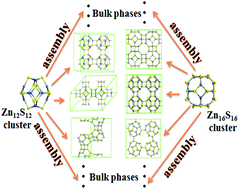Theoretical prediction of low-density nanoporous frameworks of zinc sulfide based on ZnnSn (n = 12, 16) nanocaged clusters
Abstract
Using density functional theory calculations, the possibility of the formation of different low-density framework materials based on highly stable ZnnSn (n = 12, 16) clusters is systematically investigated. Our cluster building blocks, which have high symmetries and large HOMO–LUMO gaps, are predicted to be strongly energetically preferred. Via the coalescence of ZnnSn (n = 12, 16) building blocks, many kinds of low-density ZnS framework materials of varying porosity are thus proposed. All the frameworks differ from known synthesized materials and are predicted to be energetically stable at room temperature. These new materials are found to be semiconductors with wide bandgaps, indicating that they may have promise for optoelectronic applications. Because of their nanoporous structure, they could be used for gas storage, heterogeneous catalysis, and filtration and so on. The insights we obtained here will be helpful for extending the range of properties and applications of ZnS materials.


 Please wait while we load your content...
Please wait while we load your content...